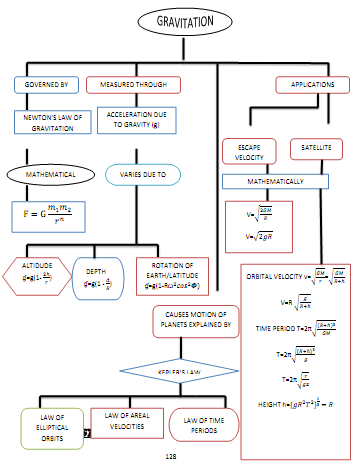CBSE Class XI PHYSICS
Revision Notes
CHAPTER 8
GRAVITATION
- Kepler’s laws, Universal law of gravitation
- Acceleration due to gravity
- Gravitational potential energy
- Escape Velocity, Orbital Velocity, Geostationary and polar satellites
-
Kepler’s law of planetry motion
(a) Kepler’s first law (law of orbit): Every planet revolves around the sun in an elliptical orbit with the sun is situated at one focus of the ellipse.
(b) Kepler’s second law (law of area): The radius vector drawn from the sun to a planet sweeps out equal areas in equal intervals of time , i.e., the areal velocity of the planet around the sun is constant.
(c) Kepler’s third law (law of period): The square of the time period of revolution of a planet around the sun is directly proportional to the cube of semi-major axis of the elliptical orbit of the planet around the sun.
- Gravitation is the name given to the force of attraction acting between any two bodies of the universe.
- Newton’s law of gravitation: It states that gravitational force of attraction acting between two point mass bodies of the universe is directly proportional to the product of their masses and is inversely proportional to the square of the distance between them, i.e , where G is the universal gravitational constant.
- Gravitational constant (G): It is equal to the force of attraction acting between two bodies each of unit mass, whose centres are placed unit distance apart. Value of G is constant throughout the universe. It is a scalar quantity. The dimensional formula . In SI unit, the value of G = .
- Gravity: It is the force of attraction exerted by earth towards its centre on a body lying on or near the surface of earth. Gravity is the measure of weight of the body. The weight of a body of mass m=mass X acceleration due to gravity=mg. The unit of weight of a body will be the same as those of force.
- Acceleration due to gravity (g): It is defined as the acceleration set up in a body while falling freely under the effect of gravity alone. It is vector quantity. The value of g changes with height, depth, rotation of earth the value of g is zero at the centre of the earth. The value of g on the surface of earth is . The acceleration due to gravity (g) is related with gravitational constant (G) by the relaion, where M and R are the mass and radius of the earth.
- Gravitational potential: The gravitational potential at a point in a gravitational field is defined as the amount of work done in bringing a body of unit mass from infinity to that point without acceleration. Gravitational potential at a point
Gravitational intensity (I) is related to gravitational potential (V) at a point by the relation,
- Gravitational potential energy of a body, at a point in the gravitational field of another body is defined as the amount of work done in bringing the given body from infinity to that point without acceleration.
Gravitational potential energy U=gravitational potential
X mass of body =
